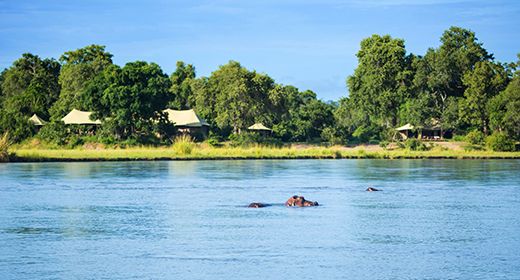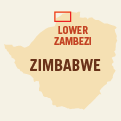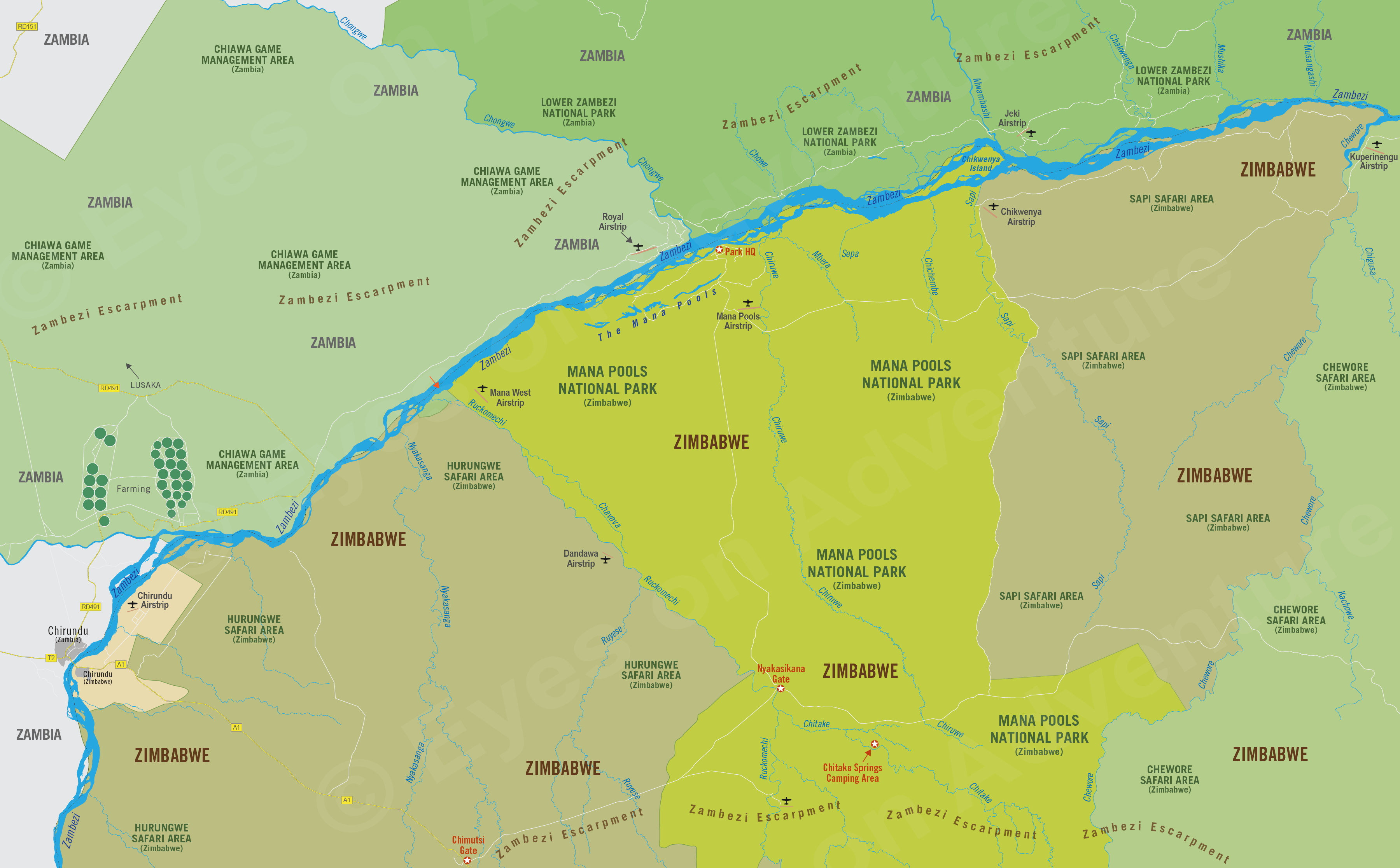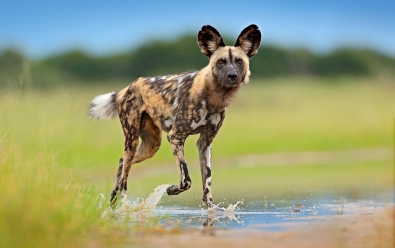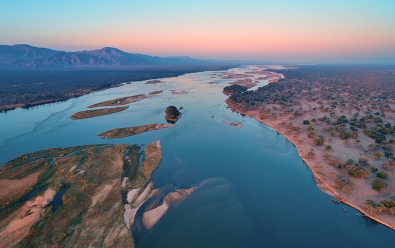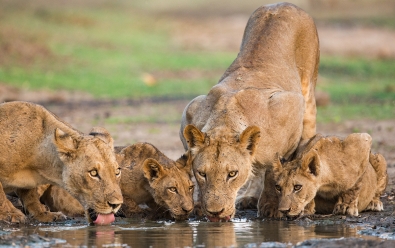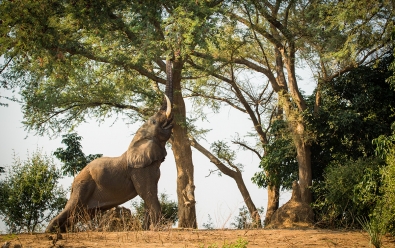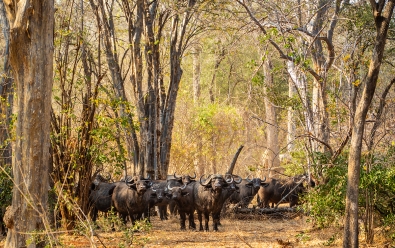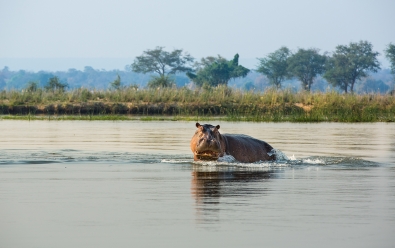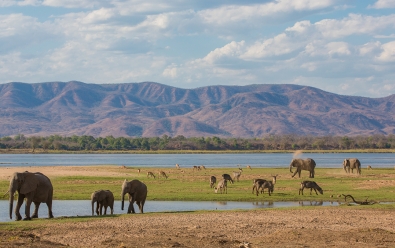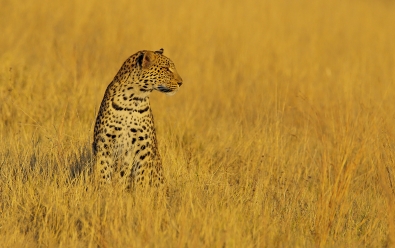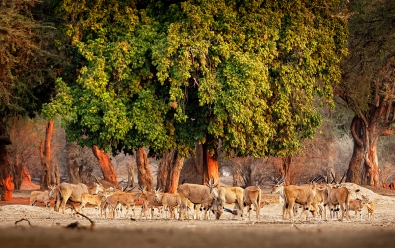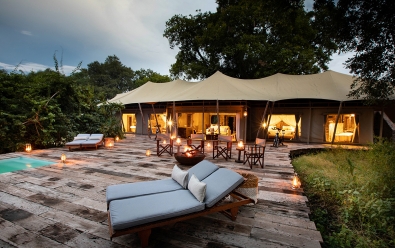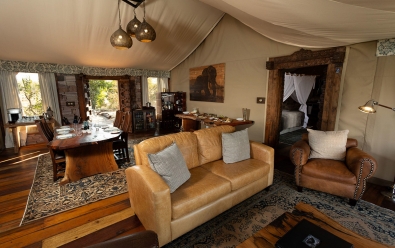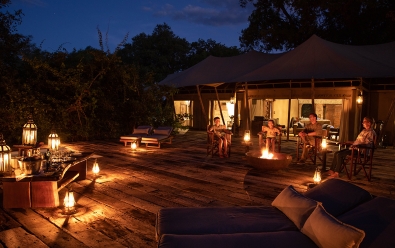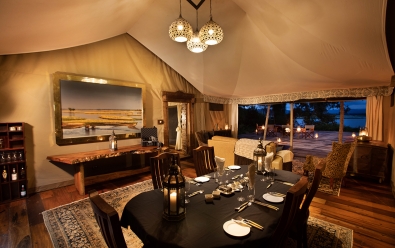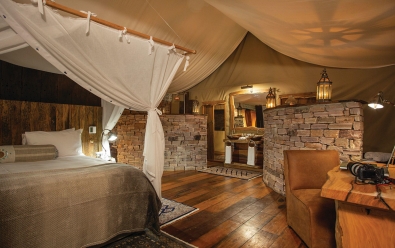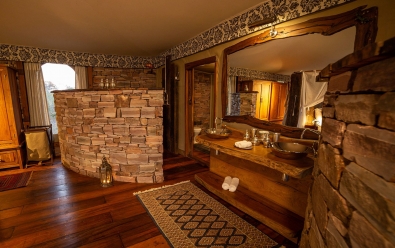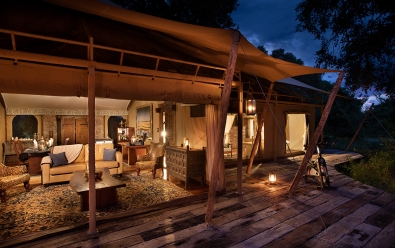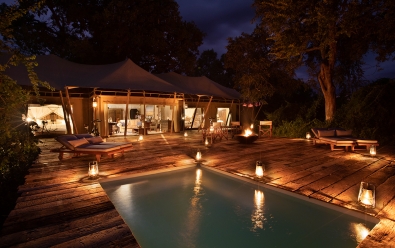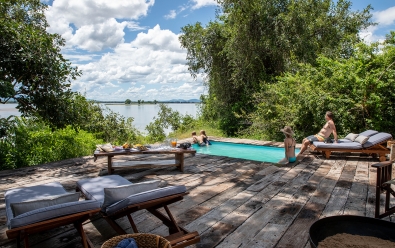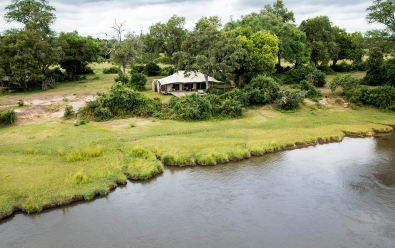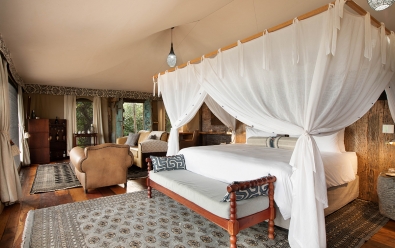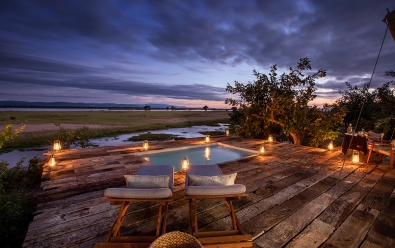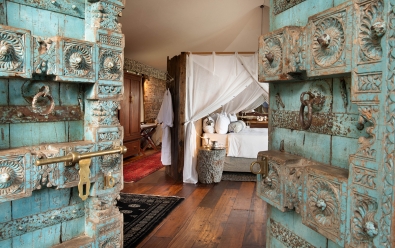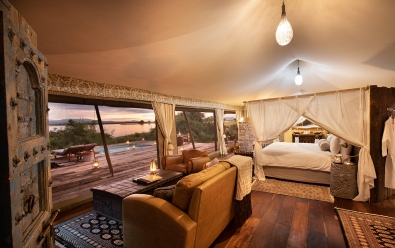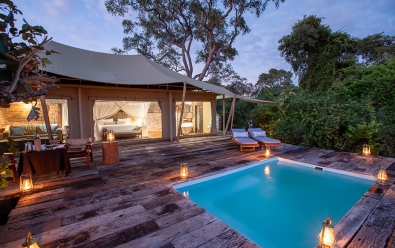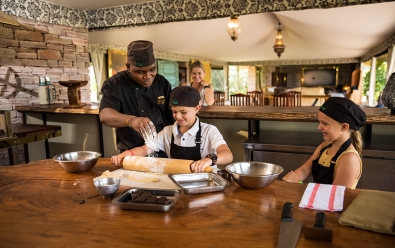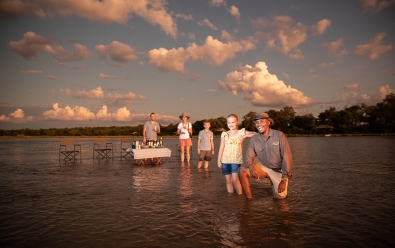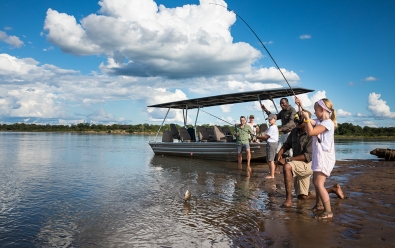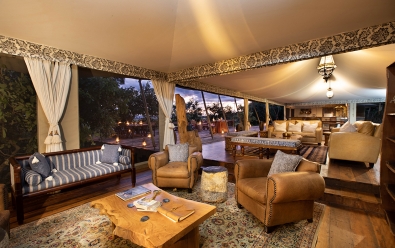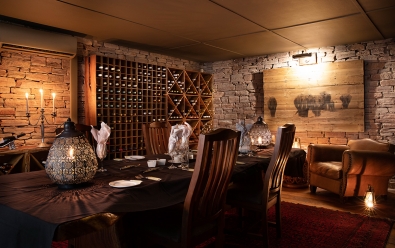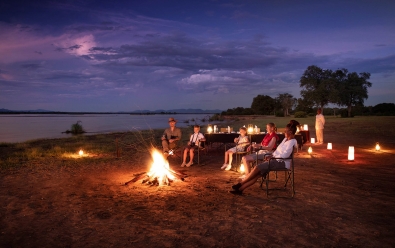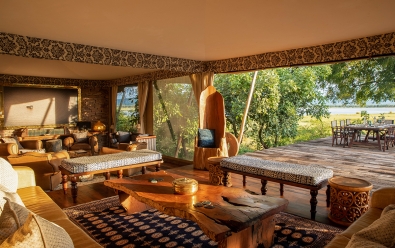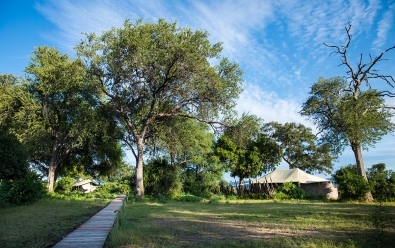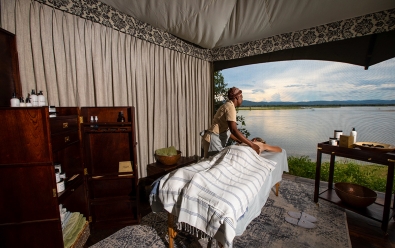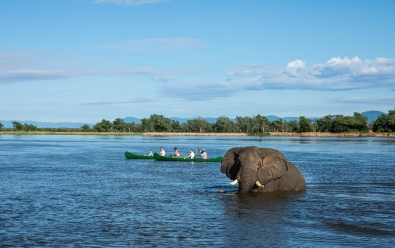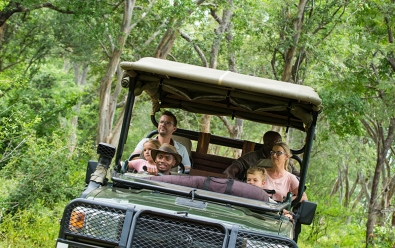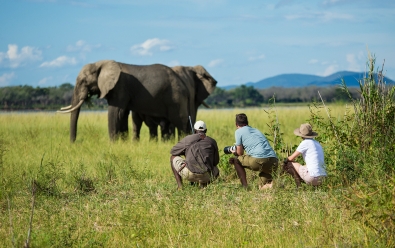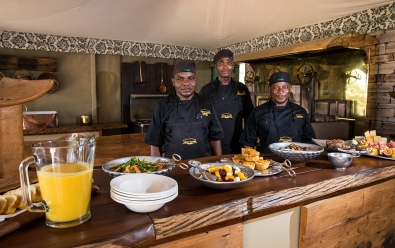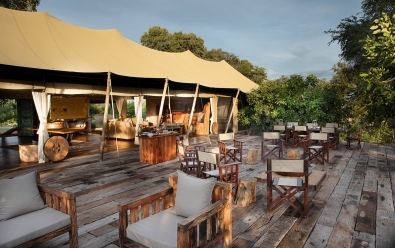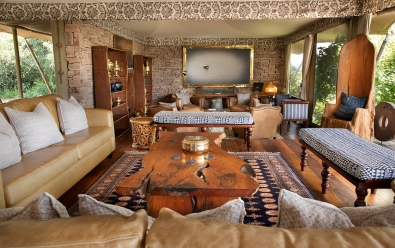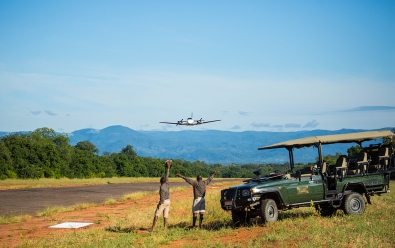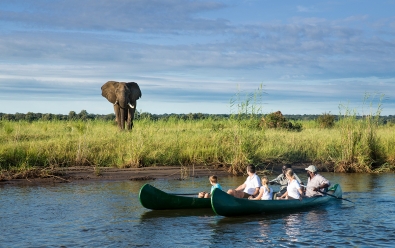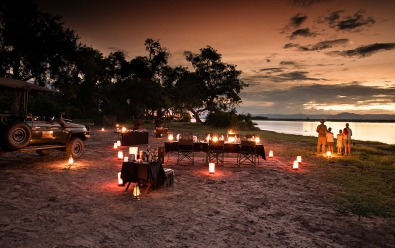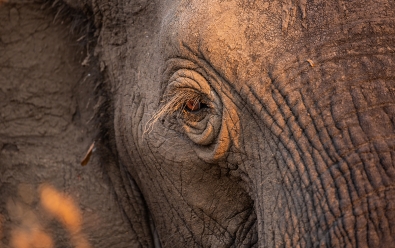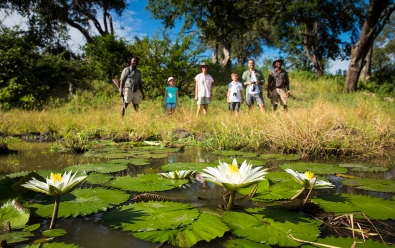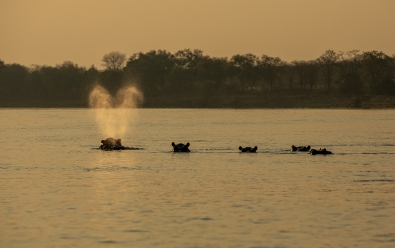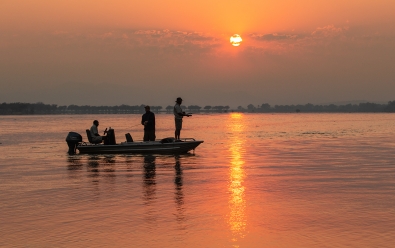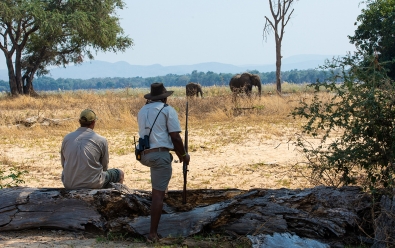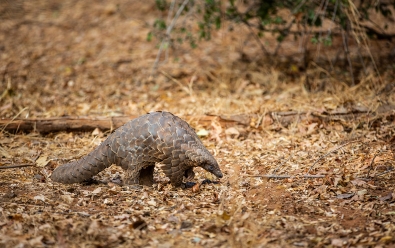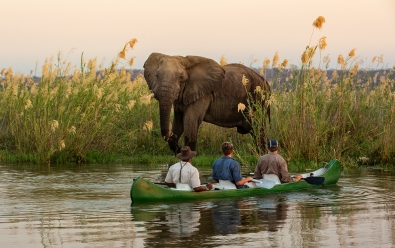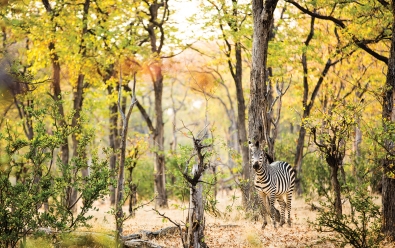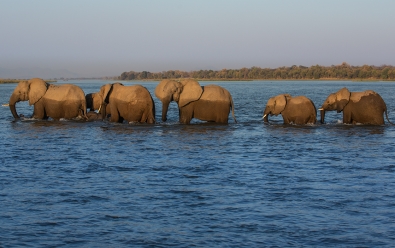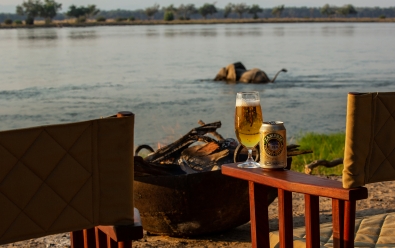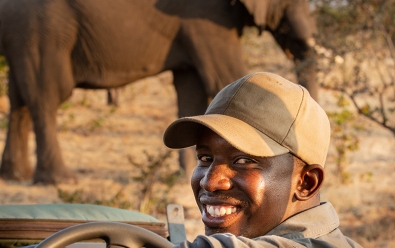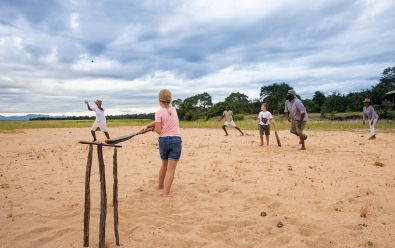Tembo Plains Camp
Highlights
- On the banks of the Zambezi River with abundant wildlife.
- A true wilderness location with no other camps nearby.
- Located in the core of an UNESCO World Heritage Site.
- Game drives, boating, canoeing, walking, fishing.
Location
- Sapi Safari Area
- Lower Zambezi River
- Northern Zimbabwe
Tembo Plains is a small, luxurious, tented safari camp located on the banks of the mighty Zambezi River and within an UNESCO World Heritage Site, where wildlife is abundant and diverse.
'Tembo', which means 'elephant', is an appropriate name for the camp, which enjoys a steady procession of these iconic animals as they move freely between Zambia and Zimbabwe by crossing the Zambezi River.
Tembo Plains is one of just a few safari camps in the 456-square-mile (1 180-sq-km) Sapi Safari Area, so guests staying at the camp will enjoy a very exclusive experience in the massive and unfenced Lower Zambezi wilderness. The camp overlooks the Zambezi River and fertile floodplains, which are a key water and grazing source for the area's abundant wildlife.
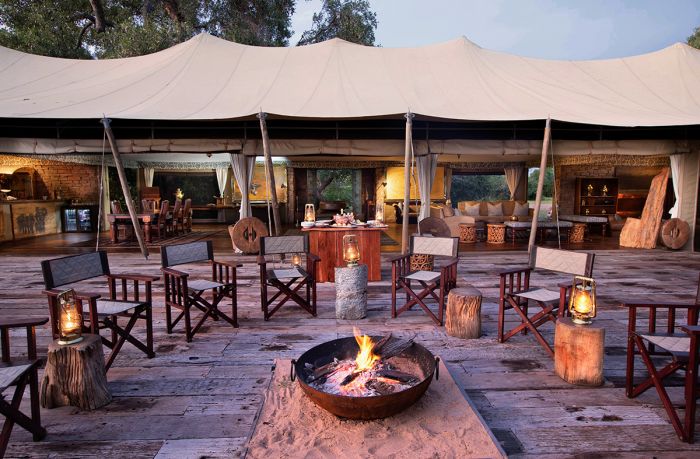
Main area deck, lounge, dining area, and bar space at Tembo Plains Camp.
Tembo Plains Camp is owned and operated by Great Plains Conservation, an organization whose mission is to blend sustainable tourism with the conservation of wildlife environments. Great Plains is headed by the husband-and-wife team of Beverly and Dereck Joubert, who are well known to wildlife enthusiasts for their outstanding films, most of which have been created in conjunction with National Geographic.
Great Plains use the term “Conservation Tourism” to describe what they do. They define it as the use of quality-led tourism experiences that are environmentally sound, with the benefits going specifically into making the conservation of an area viable and sustainable.
The Great Plains model takes stressed and threatened environments, surrounds them with compassionate protection and intelligent, sustainable management, and funds them with sensitive, low-volume, low-impact, tourism.
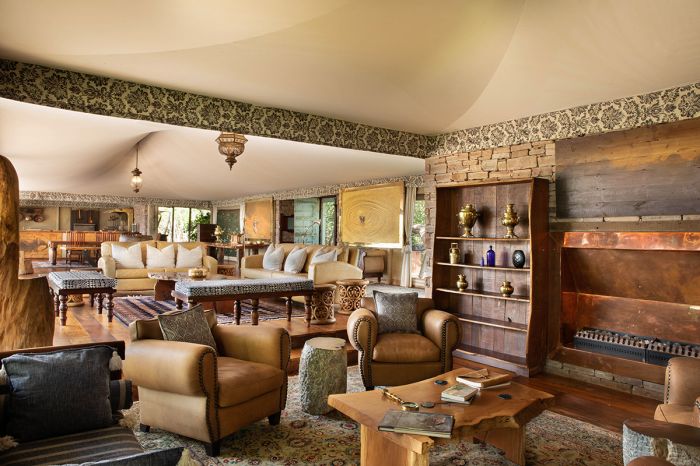
Main area lounge and view to dining room and bar at Tembo Plains Camp.
In late 2016, Great Plains was awarded conservation management of the Sapi Safari Area, which had been commercially hunted since 1957. Working with teams of world-renowned experts, Great Plains has initiated its Sapi Restoration Initiative.
The project includes developing basic infrastructure, including roads and communications systems, strategic wildlife management, wildlife monitoring teams, support for the Zimbabwe Parks And Wildlife Management Authority, wildlife species reintroduction, on-going flora and fauna surveys, and photographic tourism, all with a single goal in mind: to restore and protect this essential ecosystem.
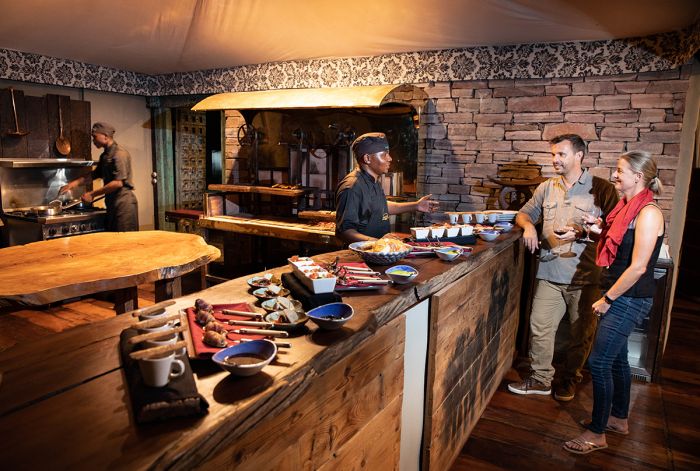
The interactive kitchen at Tembo Plains Camp.
In spite of its hunting past, wildlife viewing in the Sapi Safari Area is excellent, with large numbers of both predators and herbivores, including lion, leopard, African wild dog, spotted hyena, elephant, buffalo, zebra, eland, waterbuck, impala, greater kudu, and more. The Zambezi River is home to large numbers of both hippo and crocodile. Birding is superb, with over 400 species recorded in the region.
Activities at Tembo Plains Camp focus on game drives in custom-designed, open 4x4 vehicles to see the diverse wildlife. Water-based activities offer a different experience and include both canoeing and motorized boating on the Zambezi River (dependent on water levels), both offering up-close wildlife encounters. For those wanting to keep active, a guided bush walk is a great way to see the little things that are often missed on a safari drive.
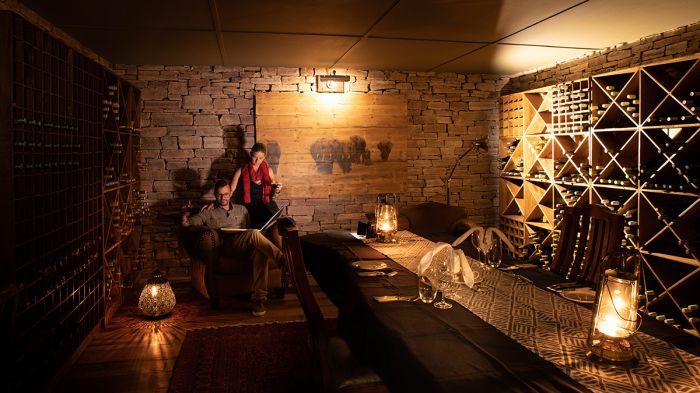
The wine storage at Tembo Plains Camp.
Tembo Plains Camp offers just 5 guest suites, one of which is a two-bedroom villa suitable for two couples traveling together or a family of up to 5 guests. The open-plan tented suites are large, with an outdoor deck that includes lounge seating, a private pool, a dining space, and an exercise bike, all overlooking the Zambezi River with views of the floodplains and into Zambia on the far side of the river. The suites include plumbed, en-suite facilities with a luxurious tub, and both indoor and outdoor showers.
The main camp area is a spacious, open-air, tented structure built atop a raised deck. Facilities in the main area include a comfortable lounge, an indoor dining space, a bar, the Tembo Plains Spa, a boutique shop, and a wine storage building. The main area lounge and dining space opens onto a large front deck fabricated from reclaimed, teak railroad ties with a campfire and outdoor dining space with excellent views of the floodplain and river.
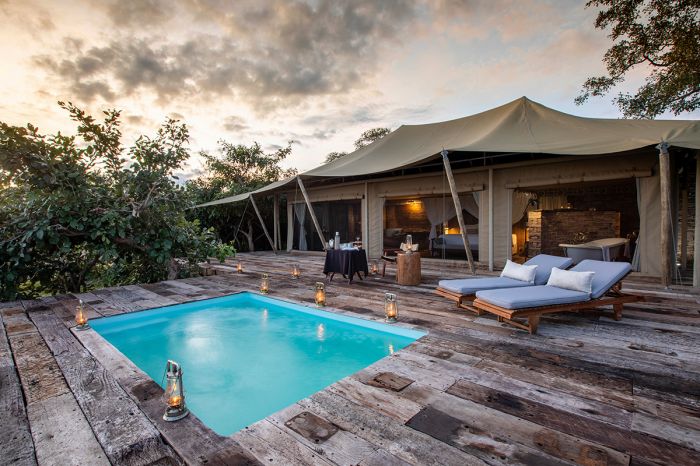
Guest suite at Tembo Plains Camp.
Great Plains are one of Africa's leading safari operators and they strive to minimize energy consumption at all their camps. The entire camp was constructed using only recycled hardwoods and canvas. Moreover, all of the camp’s electricity comes from its solar farm, while ‘bio gas’ plants recycle waste into usable cooking gas.
Tembo Plains Camp has highly-rated environmental credentials. Strict eco-friendly environmental standards are maintained so that no harmful chemicals or waste is allowed to enter the pristine ecosystem of the Selinda Reserve.
Tembo Plains Camp is Zimbabwe's only Relais & Châteaux property.
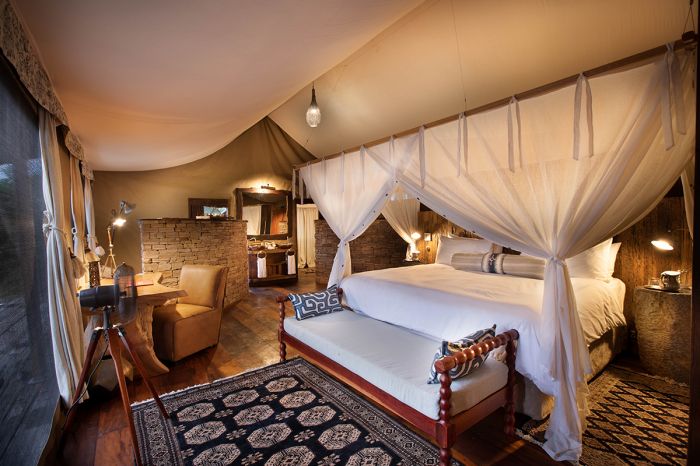
Guest suite interior at Tembo Plains Camp.
About The Lower Zambezi
The Lower Zambezi Valley is a remote protected area along the Zambezi River that covers land in both Zimbabwe (south of the river) and Zambia (north of the river). The Zambezi River forms the boundary between Zimbabwe and Zambia in this area. The Zambezi Valley is flanked on both sides by the rugged Zambezi Escarpment, which rises over 3 300 feet (1 000 meters).
The lifeblood of the entire Lower Zambezi Valley, including Mana Pools NP, is the Zambezi River, which originates hundreds of miles away in far northwest Zambia. This mighty river flows south through Zambia, over The Victoria Falls, east into Lake Kariba and into the Lower Zambezi Valley.
The Zimbabwean side of Lower Zambezi includes Mana Pools National Park and the adjoining Sapi and Chewore Safari Areas further east and was declared a UNESCO World Heritage Site in 1984. The Zambian side of the river is protected by Lower Zambezi National Park and the Chiawa Game Management Area.
The combined protected areas of the Lower Zambezi are one of Southern Africa's most diverse wildlife destinations and one its most outstanding wilderness areas.
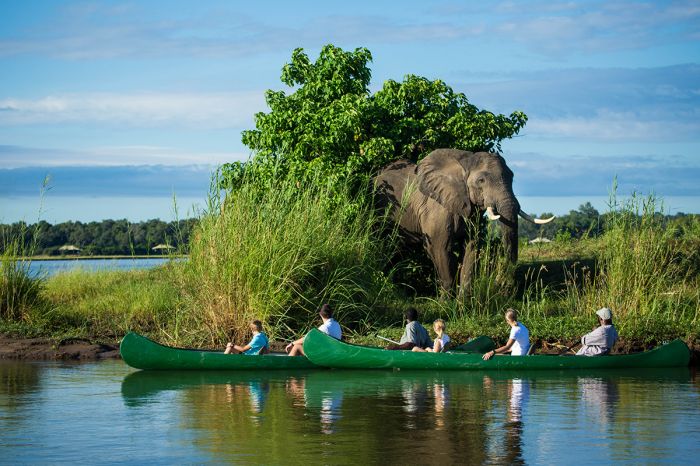
Canoeing on the Zambezi River with Tembo Plains Camp on the distant bank.
Four of Africa's Big Five animals are found in the Lower Zambezi, including elephant, lion, leopard, and buffalo. Black rhino once existed here, but they are now gone.
The region is perhaps best known for its elephants, especially the good number of extraordinary big bulls, which are very relaxed by nature and often wander through the safari camps, casually feeding while taking little notice of any humans. One popular sight which you may be lucky to see is one fo these big bull elephants standing on only its two rear legs to reach high into a tree for tasty seed pods.
Buffalo are seen in good numbers, either in breeding herds or small groups of old bulls. Like the elephants, buffalos freely cross the Zambezi River back and forth between Zimbabwe and Zambia, often stopping on one of the numerous river islands to graze.
Lions are not difficult to find, especially during the dry season when they remain near the river floodplains, which are teeming with wildlife during the winter months. Leopards are more elusive but are seen regularly. Spotted hyenas are here in good numbers, as are black-backed jackal. Cheetah are present, but only seen occasionally.
The Lower Zambezi is one of the best places in Africa to see African wild dogs, with several oft-seen packs traversing the area. These entertaining predators are seen regularly as they hunt the floodplains along the river in the early morning or near dusk.
Besides the abundant predators, the region is also home to a large variety of herbivores, including impala, zebra, waterbuck, bushbuck, greater kudu, and warthog. The region is one of the best places in Southern Africa to see eland, the continent's largest antelope. Giraffe are not found in the Lower Zambezi and there is no evidence that they ever existed here.
The Zambezi River itself is home to a huge number of hippo and crocodile and anyone canoeing or boating on the river is sure to see plenty of both species. Pods of hippo can be seen sunning along the river banks are more often just wallowing in the shallows along the banks.
Bird life is abundant, with over 400 species recorded. Large colonies of beautiful carmine bee-eaters use the river banks for nesting holes and African skimmers use sand flats for their nesting.
About Mana Pools
Mana Pools National Park is part of an extensive, unfenced natural habitat that is home to diverse and abundant wildlife on the southern side of the Zambezi River. The combined protected area includes Mana Pools National Park (848 sq mi/2 196 sq km), Sapi Safari Area (456 sq mi/1 180 sq kms), and Chewore Safari Area (1 309 sq miles/3 390 sq kms) and stretches east to the Mozambique border.
The national park is named for four semi-permanent pools just south of the river that are remnants of a prior river course and are now a favored refuge for large numbers of hippo and crocodile. The word 'mana' means 'four' in the local Shona language.
Mana Pools is well known for its superb wildlife diversity, as well as its beautiful scenery. The park is one of the most remote in Southern Africa and one never need worry about many tourists, as the small number of safari camps means it can never be crowded. The area truly feels untouched by time.
ROOMS INCLUDES & EXCLUDES CHILDREN FACILITIES ACTIVITIES
Accommodation
5 guest accommodations in total comprising:
- 4 luxurious, double-bedded wood, canvas, and natural-stone suites. Twin-bedded setup is also available.
- 1 two-bedroom wood, canvas, and natural-stone suite (Tembo Plains Suite). Read more about the Tembo Plains Suite directly below.
Each tented accommodation is constructed atop elevated wooden decking with views of the Zambezi River and floodplains with Zambia on the opposite bank. The fully-plumbed, en-suite facilities include a luxurious clawfoot-bath, indoor shower, outdoor shower, double-basin vanity, and separate toilet.
The guest suites are connected to the main camp area by a wooden walkway on the ground.
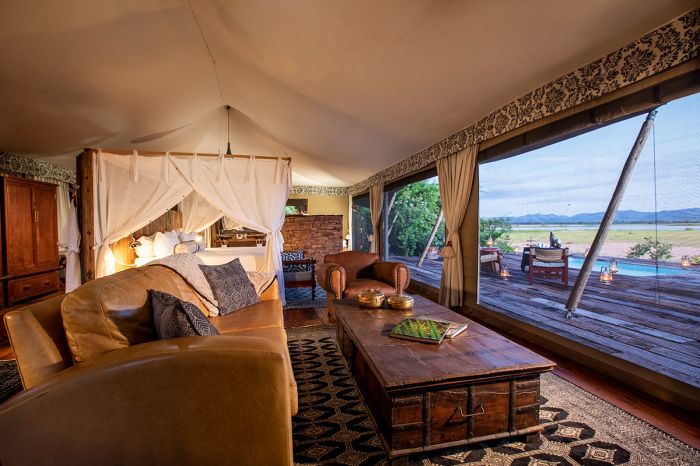
Guest suite interior and view to pool deck at Tembo Plains Camp.
Tembo Plains Suite
Located at the far side of the camp on the other side of the Tembo Plains Spa, the Tembo Plains Suite is an exclusive-use, two-bedroom tented villa. The suite includes a private guide and safari vehicle and the option of privately-served, chef-created meals.
Huge, ornate, wooden doors, open onto a spacious central lounge and dining space with the two bedrooms flanking this communal area on either side. The lounge features a couch and lounge chairs, a dining table, a fully stocked bar with refrigerated drinks, and a coffee-and-tea station. The lounge opens onto the outdoor deck in the front of the suite. The poolside area includes pool loungers and a campfire area with seating.
Both bedrooms have an open-plan layout, each with its own bathroom area situated behind beautiful, natural-stone, half-walls. The bathrooms include a luxurious, claw-foot bath, indoor and outdoor showers, a twin-basin vanity, and separate flush toilet.
As with the standard one-bedroom suites, the Tembo Plains Suite is constructed atop an elevated platform made from reclaimed, teak railroad ties. The expansive outdoor deck includes a private pool for relaxing during the midday, loungers, a campfire area with seating, and a dining space for al-fresco meals. The deck offers superb views over the Zambezi River and floodplains with Zambia on the opposite bank.
The Tembo Plains Suite can accommodate 4 adults sharing or a maximum of 5 guests for families with children.
The standard guest suites are spacious and have all the necessary creature comforts, while still offering a classic, yet luxurious, tented-safari experience.
The suites are constructed atop elevated platforms made from reclaimed, teak railroad ties with expansive front decks that offer panoramic views onto the Zambezi River and floodplains with Zambia on the far bank. The deck also includes a private pool for relaxing between activities.
Large, ornate, wooden doors lead into the spacious bedroom, which can be arranged as a double or twin-bedded setup. The open-plan suites include a lounge area with comfortable chairs, a fully-stocked bar with refrigerated drinks of choice, and a coffee/tea station.
The bathroom facilities are tucked behind lovely, natural-stone, half-walls. Other features include a writing desk and chair and mosquito netting for the beds.
Items and features in all of the guest units include:
- Writing desk and chair.
- Mosquito netting over the beds.
- Solar-powered, environmentally-friendly, air-cooling system over the bed.
- Electronic safe.
- Standing fan.
- Fully-stocked bar with refrigerated drinks.
- Tea and coffee making facilities.
- Hairdryer.
- Exercise bike for each bedroom, yoga mats, and free weights.
- One pair of high-quality binoculars and a professional camera body and lens kit for complimentary use. Photos will be downloaded to a memory stick on guest’s departure.
- Wi-Fi in the guest suites and main camp area (no mobile signal).
- Multi-plug charging facilities for mobile devices.
- Personal amenities, including soap, shampoo, conditioner, and lotion.
Tembo Plains Camp can accommodate a maximum of 13 guests in total: 2 guests in each of the 4 standard suites and up to 5 persons in the Tembo Plains Suite.
Includes & Excludes
Includes:
- All meals and alcoholic and non-alcoholic beverages, including premium brand spirits and Champagne.
- Safari experiences (twice-daily or full-day game drives, bush walks, boating and canoeing subject to water levels, catch-and-release fishing, and birding) accompanied by an experienced guide.
- One full-day game drive experience into Mana Pools National Park for guests staying a minimum of 3 nights. Additional day visits to the national park or for guests staying less than 3 nights, there is an additional charge.
- Laundry services are provided on a daily basis (weather permitting, items will be returned on the same day). Laundry is dried by the sun and on most days any laundry placed out in the morning will be returned by the evening.
- One pair of high quality binoculars and a professional camera body and lens kit for complimentary use. Photos will be downloaded to a memory stick on guest’s departure.
- Wi-Fi access.
- Tourism Levy & VAT.
Excludes:
- Purchases from the Great Plains Boutique.
- Spa services.
- Any applicable wildlife fee, park fee, reserve fee, concession fee, other land-use fee.
Single Supplement
A single supplement may apply for any room booked by a single traveler; please ask us for pricing.
Children
Children aged 6 years and older are accommodated at Tembo Plains Camp:
- Triples for children sharing with adults can be arranged upon request.
- Child rates are applicable for one child aged 15 years and younger, sharing with two adults in a suite.
- Children 15 and younger must share a room with at least one adult.
- Children aged 16 years and older will pay applicable adult rates and be accommodated in a separate suite. Alternatively, families should consider booking the Tembo Plains Suite.
- Families will be combined with other guests on all activities unless a private vehicle is booked at extra cost.
- Children can participate in walking activities from 8 years of age.
- Children can participate in canoeing activities from 12 years of age.
- Walking is possible from 6 years of age if guests are in the Tembo Plains Suite or have confirmed the additional services of a private vehicle.
- Young children must be supervised by their parents, as the camp is not fenced and is located in an area with high predator densities and there is water surrounding camp. The camp also features raised decks and pools which are not covered.
- The Great Plains Young Explorers program is thoughtfully designed to give children a range of experiences and topics from birding to cooking to art to wildlife tracking.
Facilities
Tembo Plains Camp is situated on the banks of the Zambezi River in the Lower Zambezi Valley ('lower' meaning all sections of the waterway downstream from the Victoria Falls). Every area of the camp offers excellent views of the floodplains, the river itself, and into Zambia on the opposite side of the river. The river and floodplains in front of camp attract abundant and varied wildlife.
The main camp area consists of a large, open-air, canvas structure supported by wooden beams. The structure sits atop an elevated, wooden decking made from reclaimed, teak railroad ties. The space includes a large lounge, an indoor dining space, the bar, and a wine storage. The main area opens onto a large front deck with more space for outdoor dining and a campfire area.
The main camp also includes separate structures for the Interactive Kitchen, Tembo Plains Spa, and the Great Plains Boutique for shopping. The large solar-panel farm that powers the camp is located nearby.
The entire camp was constructed using only salvaged wood and includes beautiful works of art, as well as Beverly Joubert's photographic images.
All of the camp’s electricity comes from its solar farm, while ‘bio gas’ plants recycle waste into usable cooking gas.
Main guest area facilities include:
- Central lounge, library, dining room, wine storage, bar, and a coffee/tea station.
- Expansive deck with fire pit, seating, and dining table.
- Dining is typically communal, but private dining is available on request.
- All dietary requirements are catered for, from regular to vegan to children; prior notice required.
- Interactive kitchen.
- The Spa at Tembo Plains offers guests two treatment areas with a range of treatments available. All ingredients used in the spa treatments have been personally chosen by Dereck and Beverly Joubert, in conjunction with Spacology. Spa treatments are at an additional cost.
- The Great Plains Safari Boutique offers locally and regionally-produced crafts, many of which support local community projects in the nearby Okavango panhandle. The Boutique also stocks Dereck and Beverly Joubert's clothing line, which is a bespoke range of clothing they typically wear and which is ideal and cool while on safari, yet also elegant when in the city. All materials are responsibly sourced.
- Complimentary Wi-Fi access.
- Mobile phone signal unavailable.
- Mineral water is provided in the main camp areas and in the guest suites.
- The camp is run by an impressive, Tesla solar system with a generator back-up. The system produces 220-volt, 24-hour electricity to the suites and main areas. There are universal plug points in each suite.
Activities
Activities included in the rate:
- Twice daily (or full-day with picnic lunch) game drives. Drives after dark are also offered. The vehicles are custom-built Land Cruisers that are designed specifically for the conditions around the camp and photography (fold-down screens, raised roofs, photographic bars, multi-plug inverters) with seven individual bucket seats.
- One full-day safari drive experience into Mana Pools National Park for guests staying a minimum of 3 nights. Additional day visits to the national park or for guests staying less than 3 nights, there is an additional charge.
- During winter months, hot water bottles (on early morning game drives only), blankets, and lined ponchos are provided.
- Guided walks led by licensed guides with firearm training.
- Each guest suite includes the use of a professional camera body and lenses. Photos will be downloaded to a USB flash stick on guest’s departure. The suites also include a pair of high-quality binoculars for use during your stay.
- Birding.
- Boating and canoeing on the Zambezi River, water-levels dependent.
- Rod-and-reel fishing on the Zambezi River on a catch-and-release basis.
Optional activities at additional cost:
- Private activities are on offer (subject to vehicle availability which needs to be booked in advance). Note that guests staying in the Tembo Plains Suite are assigned their own private guide and game-drive vehicle.
- Full-day safari drives into Mana Pools National Park. Note that guests staying a minimum of three nights are allotted one national park visit included during their stay.
Example of a typical day:
- Early morning wake-up call. Morning wake-up and activity times vary according to the seasons, activities on offer, and wildlife sightings.
- Light breakfast before departing on the morning activity.
- Return to camp for a meal and rest period.
- Meet for afternoon tea and snacks (savory and sweet choices) before departing on the activity.
- Return to camp - freshen up or meet for drinks, followed by dinner.
- Enjoy a nightcap or discussion around the fire before retiring.
Great Good Fair Poor
- Jan
- Feb
- Mar
- Apr
- May
- Jun
- Jul
- Aug
- Sep
- Oct
- Nov
- Dec
When to Visit
Zimbabwe's Lower Zambezi, like most of Southern Africa, has distinct seasons defined primarily by rain. Temperatures are mild to hot year-round.
The summer/rainy season runs from around mid-November thru mid-April, and many of the safari camps are closed or have limited activities at this time. The winter/dry season (Jun-Oct) is the best time to visit the Lower Zambezi for wildlife viewing.
Tembo Plains Camp is open from 01 April to 20 November.
WINTER / DRY SEASON
The dry season is the best time to visit the Lower Zambezi in Zimbabwe. The season runs from May thru October and during this time, there is almost no rain whatsoever.
The wildlife viewing is at its best in winter, with herds of elephant, buffalo, and antelope congregating along the permanent waters in the Zambezi River. Rainwater pans and minor waterways inland from the Zambezi River dry up up as the season progresses and the animals are forced to remain close to the river.
Many of the safari camps in the area are only open during the dry season, but due to the very low density of accommodations here, the national park and areas bordering the park are never crowded and you may not see any other people other than those in your camp.
May is a lovely time to visit, with lush, green vegetation still covering the landscape. Late rains are possible, but most days are sunny and clear. Daytime temps average 73-77°F (23-25°C), with overnight lows averaging 49-51°F (9-11°C).
June and July are the chilliest months of the year and rain is extremely unlikely. The bush begins to lose its verdant color and by late July, has become dry. Daytime temps are warm, averaging 75-78°F (24-26°C), but the early mornings are chilly and morning game drives will require dressing in layers. Overnight temps drop to an average of 47-51°F (8-10°C). Wildlife viewing, particularly around and remaining water sources and along the Zambezi River, is very good.
August and September are the very best months to visit the Lower Zambezi region. Game viewing is outstanding, especially along the Zambezi River, as it is basically the only water source until the rains come in November/December. The landscape is now very dry and the only good grazing is on the floodplains along the Zambezi River, where herds of elephants, zebra, buffalo, waterbuck, and other species congregate to feed. Temperatures are rising, with daytime highs reaching 86-91°F (30-33°C) and nights and early mornings only falling to a pleasant 55-63°F (13-17°C).
October is by far the warmest and driest month of the year. Wildlife viewing continues to be outstanding, with the river floodplains teeming with animals. The best time for safaris is early in the day before the sun gets too high and again later in the afternoon. Midday temperatures average 93-98°F (34-37°C) and the overnight temps only drop to 66-69°F (19-21°C). Due to the very warm days, safari drives are shorter, with animals seeking shade from mid-morning until late-afternoon.
Summer / Rain Season
The first rains typically fall anytime from late-October to mid-November, bringing relief to the parched landscape and the wildlife. The early part of the season is still a very nice time to visit the Lower Zambezi region, with fresh grasses and new vegetation starting to emerge. Some herbivores, particularly impala, time their birthing season to coincide with the arrival of the summer rains.
November rains usually only occur every other day or so on average and are typically afternoon showers only lasting 1-2 hours. Temperatures are still quite warm, with daytimes averaging 88-92°F (31-33°C). Afternoon showers cool things down if they occur. Overnight temps drop to around 64-67°F (18-19°). Some safari camps may close for the season during November.
December through February receive the most rain, with most days receiving at least some precipitation, but all-day rains are unusual. Game-drive roads can become difficult or unusable at this time. The smaller waterways, which are typically dry for most of the year, are now flowing and wildlife disperses away from the Zambezi River towards the Zambezi Escarpment to feed on the abundance of fresh vegetation. Wildlife viewing becomes somewhat more challenging, with animals now spread out away from the river.
March is approaching the end of the rainy season, with showers decreasing in frequency and volume. Temperatures are roughly the same from December through March, averaging 82-88°F (28-31°C) during the day and 64-70°F (18-21°C) overnight.
April is the transition month between the rainy and dry season, with only sporadic showers and gradually decreasing temperatures. The bush is verdant and thick after the months of rainy days and some safari tracks may still be difficult for driving. Daytime temps average 84-86°F (29-30°C) and overnight/early morning temps are comfortable, averaging 51-54°F (10-12°C).




